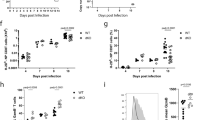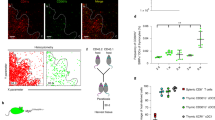Abstract
Induced regulatory T cells (iTreg cells) can be generated by peripheral dendritic cells (DCs) that mediate T cell unresponsiveness to rechallenge with antigen. The molecular factors required for the function of such iTreg cells remain unknown. We report a critical role for the transcription cofactor homeodomain-only protein (Hop; also known as Hopx) in iTreg cells to mediate T cell unresponsiveness in vivo. Hopx-sufficient iTreg cells downregulated expression of the transcription factor AP-1 complex and suppressed other T cells. In the absence of Hopx, iTreg cells had high expression of the AP-1 complex, proliferated and failed to mediate T cell unresponsiveness to rechallenge with antigen. Thus, Hopx is required for the function of Treg cells induced by DCs and the promotion of DC-mediated T cell unresponsiveness in vivo.
This is a preview of subscription content, access via your institution
Access options
Subscribe to this journal
Receive 12 print issues and online access
$209.00 per year
only $17.42 per issue
Buy this article
- Purchase on Springer Link
- Instant access to full article PDF
Prices may be subject to local taxes which are calculated during checkout




Similar content being viewed by others
Accession codes
References
von Boehmer, H. et al. Thymic selection revisited: how essential is it? Immunol. Rev. 191, 62–78 (2003).
Steinman, R.M., Hawiger, D. & Nussenzweig, M.C. Tolerogenic dendritic cells. Annu. Rev. Immunol. 21, 685–711 (2003).
Sakaguchi, S. Naturally arising CD4+ regulatory T cells for immunologic self-tolerance and negative control of immune responses. Annu. Rev. Immunol. 22, 531–562 (2004).
Schwartz, R.H. Natural regulatory T cells and self-tolerance. Nat. Immunol. 6, 327–330 (2005).
Tang, Q. & Bluestone, J.A. The Foxp3+ regulatory T cell: a jack of all trades, master of regulation. Nat. Immunol. 9, 239–244 (2008).
Mathis, D. & Benoist, C. Aire. Annu. Rev. Immunol. 27, 287–312 (2009).
Kretschmer, K. et al. Inducing and expanding regulatory T cell populations by foreign antigen. Nat. Immunol. 6, 1219–1227 (2005).
Travis, M.A. et al. Loss of integrin αVβ8 on dendritic cells causes autoimmunity and colitis in mice. Nature 449, 361–365 (2007).
Coombes, J.L. et al. A functionally specialized population of mucosal CD103+ DCs induces Foxp3+ regulatory T cells via a TGF-β and retinoic acid-dependent mechanism. J. Exp. Med. 204, 1757–1764 (2007).
Sun, C.M. et al. Small intestine lamina propria dendritic cells promote de novo generation of Foxp3 Treg cells via retinoic acid. J. Exp. Med. 204, 1775–1785 (2007).
Yamazaki, S. et al. CD8+CD205+ splenic dendritic cells are specialized to induce Foxp3+ regulatory T cells. J. Immunol. 181, 6923–6933 (2008).
Hill, J.A. et al. Foxp3 transcription-factor-dependent and -independent regulation of the regulatory T cell transcriptional signature. Immunity 27, 786–800 (2007).
Vignali, D. How many mechanisms do regulatory T cells need? Eur. J. Immunol. 38, 908–911 (2008).
Curotto de Lafaille, M.A. et al. Adaptive Foxp3+ regulatory T cell-dependent and -independent control of allergic inflammation. Immunity 29, 114–126 (2008).
Lu, L.F. & Rudensky, A. Molecular orchestration of differentiation and function of regulatory T cells. Genes Dev. 23, 1270–1282 (2009).
Feuerer, M., Hill, J.A., Mathis, D. & Benoist, C. Foxp3+ regulatory T cells: differentiation, specification, subphenotypes. Nat. Immunol. 10, 689–695 (2009).
Gavin, M.A., Clarke, S.R., Negrou, E., Gallegos, A. & Rudensky, A. Homeostasis and anergy of CD4+CD25+ suppressor T cells in vivo. Nat. Immunol. 3, 33–41 (2002).
Apostolou, I., Sarukhan, A., Klein, L. & von Boehmer, H. Origin of regulatory T cells with known specificity for antigen. Nat. Immunol. 3, 756–763 (2002).
Sugimoto, N. et al. Foxp3-dependent and -independent molecules specific for CD25+CD4+ natural regulatory T cells revealed by DNA microarray analysis. Int. Immunol. 18, 1197–1209 (2006).
Gavin, M.A. et al. Foxp3-dependent programme of regulatory T-cell differentiation. Nature 445, 771–775 (2007).
Fisson, S. et al. Continuous activation of autoreactive CD4+CD25+ regulatory T cells in the steady state. J. Exp. Med. 198, 737–746 (2003).
Klein, L., Khazaie, K. & von Boehmer, H. In vivo dynamics of antigen-specific regulatory T cells not predicted from behavior in vitro. Proc. Natl. Acad. Sci. USA 100, 8886–8891 (2003).
Kang, S.M. et al. Transactivation by AP-1 is a molecular target of T cell clonal anergy. Science 257, 1134–1138 (1992).
Sundstedt, A. et al. In vivo anergized CD4+ T cells express perturbed AP-1 and NF-κB transcription factors. Proc. Natl. Acad. Sci. USA 93, 979–984 (1996).
Schwartz, R.H. T cell clonal anergy. Curr. Opin. Immunol. 9, 351–357 (1997).
Shaulian, E. & Karin, M. AP-1 in cell proliferation and survival. Oncogene 20, 2390–2400 (2001).
Zheng, Y. et al. Genome-wide analysis of Foxp3 target genes in developing and mature regulatory T cells. Nature 445, 936–940 (2007).
Williams, L.M. & Rudensky, A.Y. Maintenance of the Foxp3-dependent developmental program in mature regulatory T cells requires continued expression of Foxp3. Nat. Immunol. 8, 277–284 (2007).
Lee, S.M., Gao, B. & Fang, D. FoxP3 maintains Treg unresponsiveness by selectively inhibiting the promoter DNA-binding activity of AP-1. Blood 111, 3599–3606 (2008).
Shin, C.H. et al. Modulation of cardiac growth and development by HOP, an unusual homeodomain protein. Cell 110, 725–735 (2002).
Chen, F. et al. Hop is an unusual homeobox gene that modulates cardiac development. Cell 110, 713–723 (2002).
Yin, Z. et al. Hop functions downstream of Nkx2.1 and GATA6 to mediate HDAC-dependent negative regulation of pulmonary gene expression. Am. J. Physiol. Lung Cell. Mol. Physiol. 291, L191–L199 (2006).
Kee, H.J. et al. Enhancer of polycomb1, a novel homeodomain only protein-binding partner, induces skeletal muscle differentiation. J. Biol. Chem. 282, 7700–7709 (2007).
Hawiger, D. et al. Dendritic cells induce peripheral T cell unresponsiveness under steady state conditions in vivo. J. Exp. Med. 194, 769–779 (2001).
Hawiger, D., Masilamani, R.F., Bettelli, E., Kuchroo, V.K. & Nussenzweig, M.C. Immunological unresponsiveness characterized by increased expression of CD5 on peripheral T cells induced by dendritic cells in vivo. Immunity 20, 695–705 (2004).
Barnden, M.J., Allison, J., Heath, W.R. & Carbone, F.R. Defective TCR expression in transgenic mice constructed using cDNA-based α- and β-chain genes under the control of heterologous regulatory elements. Immunol. Cell Biol. 76, 34–40 (1998).
Kretschmer, K., Apostolou, I., Jaeckel, E., Khazaie, K. & von Boehmer, H. Making regulatory T cells with defined antigen specificity: role in autoimmunity and cancer. Immunol. Rev. 212, 163–169 (2006).
Brunkow, M.E. et al. Disruption of a new forkhead/winged-helix protein, scurfin, results in the fatal lymphoproliferative disorder of the scurfy mouse. Nat. Genet. 27, 68–73 (2001).
Fontenot, J.D., Gavin, M.A. & Rudensky, A.Y. Foxp3 programs the development and function of CD4+CD25+ regulatory T cells. Nat. Immunol. 4, 330–336 (2003).
Wan, Y.Y. & Flavell, R.A. Identifying Foxp3-expressing suppressor T cells with a bicistronic reporter. Proc. Natl. Acad. Sci. USA 102, 5126–5131 (2005).
Itoh, M. et al. Thymus and autoimmunity: production of CD25+CD4+ naturally anergic and suppressive T cells as a key function of the thymus in maintaining immunologic self-tolerance. J. Immunol. 162, 5317–5326 (1999).
Steinman, R.M., Adams, J.C. & Cohn, Z.A. Identification of a novel cell type in peripheral lymphoid organs of mice. IV. Identification and distribution in mouse spleen. J. Exp. Med. 141, 804–820 (1975).
Steinman, R.M., Kaplan, G., Witmer, M.D. & Cohn, Z.A. Identification of a novel cell type in peripheral lymphoid organs of mice. V. Purification of spleen dendritic cells, new surface markers, and maintenance in vitro. J. Exp. Med. 149, 1–16 (1979).
Steinman, R.M. & Witmer, M.D. Lymphoid dendritic cells are potent stimulators of the primary mixed leukocyte reaction in mice. Proc. Natl. Acad. Sci. USA 75, 5132–5136 (1978).
Wu, Y. et al. FOXP3 controls regulatory T cell function through cooperation with NFAT. Cell 126, 375–387 (2006).
Deaglio, S. et al. Adenosine generation catalyzed by CD39 and CD73 expressed on regulatory T cells mediates immune suppression. J. Exp. Med. 204, 1257–1265 (2007).
Wing, K. & Sakaguchi, S. Regulatory T cells exert checks and balances on self tolerance and autoimmunity. Nat. Immunol. 11, 7–13 (2010).
Norman, C., Runswick, M., Pollock, R. & Treisman, R. Isolation and properties of cDNA clones encoding SRF, a transcription factor that binds to the c-fos serum response element. Cell 55, 989–1003 (1988).
Acknowledgements
We thank E. Olson (University of Texas Southwestern Medical Center) for Hopx−/− mice; T. Taylor for help with cell sorting; and L. Zenewicz and F. Manzo for help during preparation of the manuscript. Supported by the American Diabetes Society (D.H.), the National Multiple Sclerosis Society (TA 3024A1/2 to D.H.) and the Howard Hughes Medical Institute (R.A.F.).
Author information
Authors and Affiliations
Contributions
D.H. designed and did experiments, interpreted data and wrote the manuscript; Y.Y.W. produced FIR mice; E.E.E. contributed to interpretation of data; and R.A.F. oversaw the experimental design, interpreted data and wrote the manuscript.
Corresponding author
Ethics declarations
Competing interests
The authors declare no competing financial interests.
Supplementary information
Supplementary Text and Figures
Supplementary Figures 1–7 (PDF 1512 kb)
Rights and permissions
About this article
Cite this article
Hawiger, D., Wan, Y., Eynon, E. et al. The transcription cofactor Hopx is required for regulatory T cell function in dendritic cell–mediated peripheral T cell unresponsiveness. Nat Immunol 11, 962–968 (2010). https://doi.org/10.1038/ni.1929
Received:
Accepted:
Published:
Issue Date:
DOI: https://doi.org/10.1038/ni.1929
This article is cited by
-
Study on the expression changes of lncRNA in patients with systemic lupus erythematosus and its correlation with Treg cells
Clinical Rheumatology (2024)
-
Downregulated cytotoxic CD8+ T-cell identifies with the NKG2A-soluble HLA-E axis as a predictive biomarker and potential therapeutic target in keloids
Cellular & Molecular Immunology (2022)
-
Longitudinal DNA methylation differences precede type 1 diabetes
Scientific Reports (2020)
-
HOPX hypermethylation promotes metastasis via activating SNAIL transcription in nasopharyngeal carcinoma
Nature Communications (2017)
-
Distinct gene expression patterns correlate with developmental and functional traits of iNKT subsets
Nature Communications (2016)



